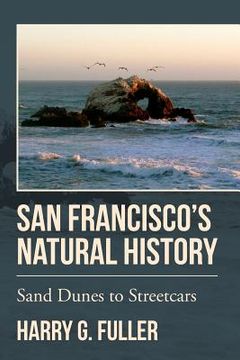Reseña del libro "San Francisco's Natural History: Sand Dunes to Streetcars (en Inglés)"
This book traces the changes in the environment, the plants and animals starting with the Ohlone through the colonial period and in the decades since the Gold Rush. It describes what the flora and fauna were like before the presidio and mission were founded, what plants and animals disappeared and which survived. There is also discussion of the many introduced species, the landscape changes by humans and the on-going effects of climate change. There is description of introduced and invasive species and how they have affected the ecology in the San Francisco's limited open space. Accounts are summarized from the first natural history observations in San Francisco. These include records that begin with Sir Francis Drake and include the DeAnza, Vancouver, Beechey, Rezanov and LaPerouse expeditions. Book includes map of what San Francisco's landscape and streams was like in 1800 before people began making wholesale changes. EXCERPTS: The want of sufficient level space on which to found so great and growing a city, has been partially rectified, at an enormous expense, by taking building ground from the waters, and by lowering, and in many cases absolutely removing bodily the multitude of sand hills, by which the place is immediately surrounded. What with digging out and filling up, piling, capping and planking, grading and regrading the streets, and shifting, and rebuilding, and again rebuilding the houses, to suit the altered levels, millions upon millions of dollars have been spent. ¬-Frank Soule, et al., The Annals of San Francisco, 1855 *** Nature's plan has evolved through millions of years while man's plans for the earth cover a short span of time and are very often both selfish and short-sighted. -Helen Cruickshank, Thoreau's Birds, 1964 *** In 1792-1793, Archibald Menzies, the medical officer for the British Expedition, headed by Captain George Vancouver, was immediately taken with the dramatic "broad sheet of water" that is the bay, described in the epigraph to this chapter. The observations by Menzies and other expedition crew are valuable as baseline information about how the area was changed over the decades that followed their visit. During their stay in the fall of 1792, the British sailors reported a large number of waterfowl in the marsh that is now Crissy Field. Menzies describes the area between Fort Mason and Fort Point as a "low track of Marshy Land along shore, with some Salt Water Lagoons that were supplied by the overflowings of high Tides and oozings through the Sandy Beach: on these we saw abundance of Ducks and wild Geese..." Vancouver mentions large livestock flocks. He is visiting in 1792, less than two decades after the first colonists arrived from Mexico. Yet, already hundreds of domestic animals are ranging across a fragile landscape. *** 1820 Estimated 200,000 northern fur seals killed for their pelts. 1932 First Mockingbird sighted in San Francisco. *** One of the few surface streams still to be seen in San Francisco runs down Glen Canyon. It constitutes the headwaters of Precita Creek, which joins Islais Creek, named from the Ohlone word for hollyleaf cherry... In 1869 America's first dynamite factory, the Giant Powder Company, blew up in Glen Canyon. Also, in the late 1800s, the canyon, then known as Rock Gulch, supported a private zoo and amusement park. *** Climate change: Just how bad can this get? A scientific look back at a previous die-off caused by ocean acidification brings up terrifying images if you value any currently living creature. Volcanologist Seth Burgess studied the geological and biological changes that took place at the end of the Permian period about 250-255 million years ago. It wasn't simply the end of a geological age, it was the end of most living organisms. Fossil records show that 90% of all ocean organisms and 70% of those on land went extinct. Trees and coral reefs disappeared.

